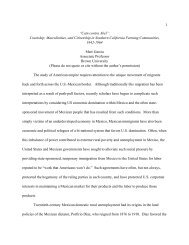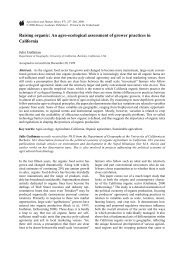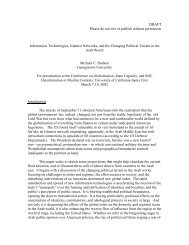The Death of Ramon Gonzalez and the 21st Century Dilemma
The Death of Ramon Gonzalez and the 21st Century Dilemma
The Death of Ramon Gonzalez and the 21st Century Dilemma
Create successful ePaper yourself
Turn your PDF publications into a flip-book with our unique Google optimized e-Paper software.
study strongly suggests permanent nervous system damage done to children due to<br />
pesticide exposure at sub-acute levels. Comparable studies done in Central America have<br />
had similar results, with additional documentation <strong>of</strong> loss <strong>of</strong> reasoning <strong>and</strong> o<strong>the</strong>r mentalprocessing<br />
skills in adults as well as children due to sub-acute levels <strong>of</strong> pesticide<br />
poisoning. xxvii [here insert <strong>the</strong> line drawings from G.’s study]<br />
<strong>The</strong>se studies are most important because <strong>the</strong>y demonstrate under actual field<br />
conditions <strong>the</strong> fallacy <strong>of</strong> <strong>the</strong> view that acute exposure to organophosphate <strong>and</strong> carbamate<br />
pesticides short <strong>of</strong> death would not lead to permanent or chronic health problems—if<br />
recovery occurred, it would be complete, without fur<strong>the</strong>r consequences. This was <strong>the</strong><br />
optimistic doctrine that reigned in pesticide toxicology when I did <strong>the</strong> original work for<br />
<strong>The</strong> <strong>Death</strong> <strong>of</strong> <strong>Ramon</strong> <strong>Gonzalez</strong>. Subsequently, not only <strong>the</strong>se field studies, but o<strong>the</strong>r<br />
epidemiological, field, <strong>and</strong> laboratory studies have demonstrated a variety <strong>of</strong> permanent<br />
<strong>and</strong> chronic health problems in humans <strong>and</strong> wildlife due to central nervous system<br />
poisons widely used as pesticides. We will discuss this fur<strong>the</strong>r below.<br />
Frequent use <strong>of</strong> large quantities <strong>of</strong> highly toxic pesticides in ways that seriously<br />
harm farmworker health has been documented recently in o<strong>the</strong>r Mexican regions. <strong>The</strong><br />
most thorough study comes from <strong>the</strong> coastal region just south <strong>of</strong> <strong>the</strong> state <strong>of</strong> Sinaloa, in<br />
<strong>the</strong> states <strong>of</strong> Nayarit <strong>and</strong> Jalisco. This is tobacco country, with tobacco grown for<br />
domestic <strong>and</strong> export markets under <strong>the</strong> supervision <strong>of</strong> transnational tobacco firms. xxviii<br />
Most <strong>of</strong> <strong>the</strong> workers who cultivate <strong>and</strong> harvest <strong>the</strong> tobacco are Huichols, members<br />
<strong>of</strong> one <strong>of</strong> <strong>the</strong> most remarkable ethnic groups in Mexicos. <strong>The</strong> Huichols, who mostly live<br />
in <strong>the</strong> rugged mountains <strong>of</strong> western Jalisco <strong>and</strong> Nayarit, with some coastal settlements,<br />
successfully resisted Spanish conquest. <strong>The</strong>y also largely resisted outside control through





